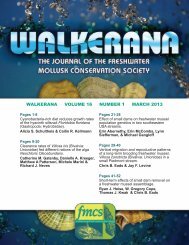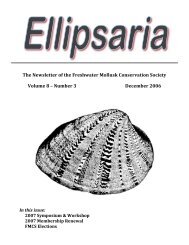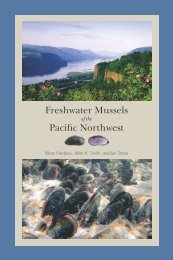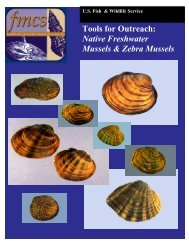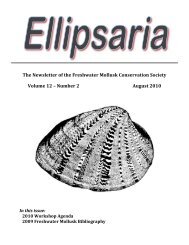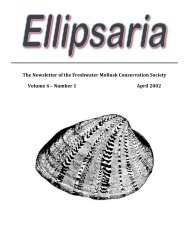August 2004 - FMCS-Freshwater Mollusk Conservation
August 2004 - FMCS-Freshwater Mollusk Conservation
August 2004 - FMCS-Freshwater Mollusk Conservation
Create successful ePaper yourself
Turn your PDF publications into a flip-book with our unique Google optimized e-Paper software.
Call for 2005 <strong>FMCS</strong><br />
Professional Award Nominations<br />
Do you know someone who has made worthwhile<br />
contributions to mussel conservation or to the Society either<br />
through donating their professional time or expertise or<br />
through their scientific endeavors? Consider nominating<br />
them for one of the <strong>FMCS</strong> Professional Awards.<br />
Nominations and supporting documentation are due on 30<br />
November <strong>2004</strong>. See the preceding article in this newsletter<br />
or go to Awards Committee web site for more details.<br />
Contact Dr. Greg Cope, greg_cope@ncsu.edu or<br />
919.515.5296, for more information.<br />
Mississippi Mussel Guide<br />
Each current <strong>FMCS</strong> member has received a copy of<br />
"<strong>Freshwater</strong> Mussels of the Upper Mississippi River" with<br />
this newsletter. This booklet was produced by the<br />
Wisconsin Department of Natural Resources and funded in<br />
part by <strong>FMCS</strong>. It is a revision of the popular 1985 booklet.<br />
Publications<br />
New Guide to the <strong>Freshwater</strong> Mussels<br />
of the New York Metropolitan Region<br />
and New Jersey<br />
<br />
James (Jay) R. Cordeiro<br />
NatureServe, 11 Avenue de Lafayette, 5 th Fl., Boston, MA<br />
02111 and<br />
Division of Invertebrate Zoology, American Museum of<br />
Natural History, Central Park West at 79 th Street, New York,<br />
NY 10024<br />
jay_cordeiro@natureserve.org<br />
Due to the overwhelming positive response and instructional<br />
value to the American Museum of Natural History’s Center<br />
for Biodiversity and <strong>Conservation</strong> (CBC) annual<br />
identification workshops (butterflies and moths, dragonflies<br />
and damselflies, freshwater mollusks, bees), the CBC has<br />
developed a web handbook as a short-course to the<br />
freshwater mussels occurring within 75 miles of New York<br />
City (including southwestern Connecticut) and throughout<br />
New Jersey. It was based on a 2000 taxonomic workshop on<br />
freshwater mollusks taught by Dr. David Strayer and myself<br />
and is designed for naturalists, biologists, and resource<br />
managers working to conserve local freshwater ecosystems.<br />
The handbook includes a section on mussel identification<br />
morphology, a photo illustrated guide to 14 species plus<br />
9<br />
three species of invasive freshwater bivalves, a<br />
dichotomous key, conservation status assessment, habitat<br />
guide, glossary, bibliography of print and web resources, and<br />
essays on freshwater mussel taxonomy, diversity and<br />
distribution, biology, ecology, threats, conservation, and<br />
study methods, including a guide to local regulations. Keys<br />
and resources about other invertebrate taxa are also<br />
available. The handbook is generously illustrated with color<br />
photographs of specimens from multiple viewpoints,<br />
morphological shell features, county level distribution maps,<br />
and sample habitat photographs for each taxon. All<br />
information is freely available online at:<br />
http://cbc.amnh.org/mussel/<br />
<strong>Conservation</strong> Plan for <strong>Freshwater</strong><br />
Mussels of the UMR System<br />
The <strong>Conservation</strong> Plan for <strong>Freshwater</strong> Mussels of the Upper<br />
Mississippi River System (revised May <strong>2004</strong>), prepared by<br />
the Mussel Ad Hoc Committee of the UMRCC, is available<br />
at: http://www.mississippi-river.com/umrcc/<br />
This is intended to be a "living document" that will be<br />
revised periodically as new information becomes available<br />
and new strategies are developed. The authors welcome any<br />
comments and suggestions that would help enhance short-<br />
and long-term mussel conservation goals.<br />
Gary Wege, U.S. Fish and Wildlife Service Biologist<br />
gary_wege@fws.gov<br />
New Internet Publication:<br />
History of Malacology<br />
The American Malacological Society has recently posted<br />
2,400 Years of Malacology by Eugene V. Coan, Alan R.<br />
Kabat, and Richard E. Petit on their website:<br />
http://erato.acnatsci.org/ams/publications/2400_malacology.html<br />
This is a comprehensive catalog of biographical and<br />
bibliographical papers on malacologists, conchologists,<br />
paleontologists, and others with an interest in mollusks. At<br />
present, the catalog is over 600 pages and indexes over<br />
5,000 individuals. This catalog is a work in progress, and<br />
updated versions will be posted periodically.<br />
Thorsen, W. A., W. G. Cope, and D. Shea. <strong>2004</strong>.<br />
Bioavailability of PAHs: Effects of soot carbon and<br />
PAH source. Environmental Science and Technology<br />
38 (7): 2029-2037.<br />
Article includes information on native freshwater (e.g.,<br />
Elliptio complanata) and marine bivalves. Contact<br />
Greg Cope (greg_cope@ncsu.edu) for a reprint.<br />
Peeples, G.E. <strong>2004</strong>. Dick Biggins, recovery hero.<br />
Endangered Species Bulletin 28(4):24-25.



